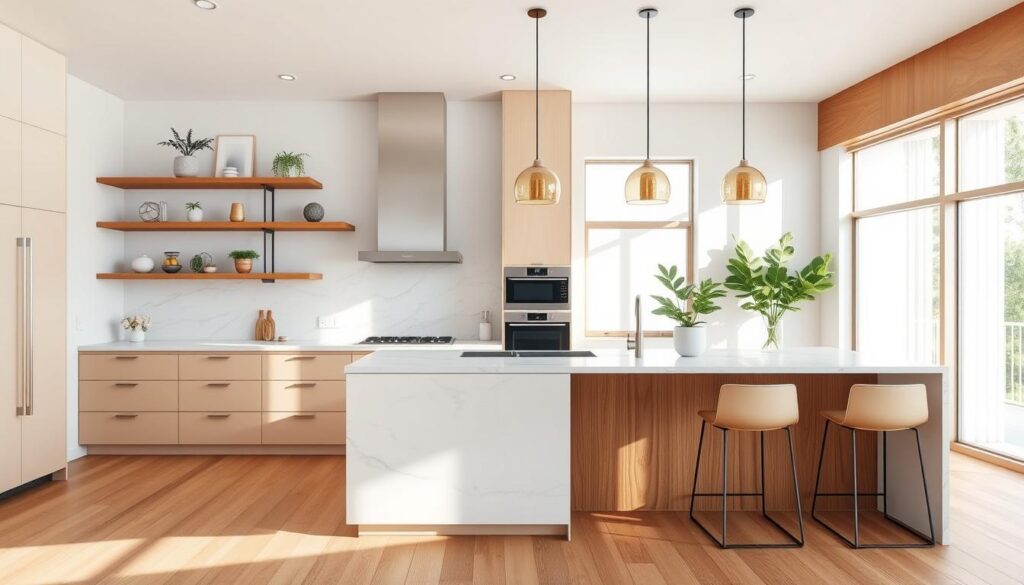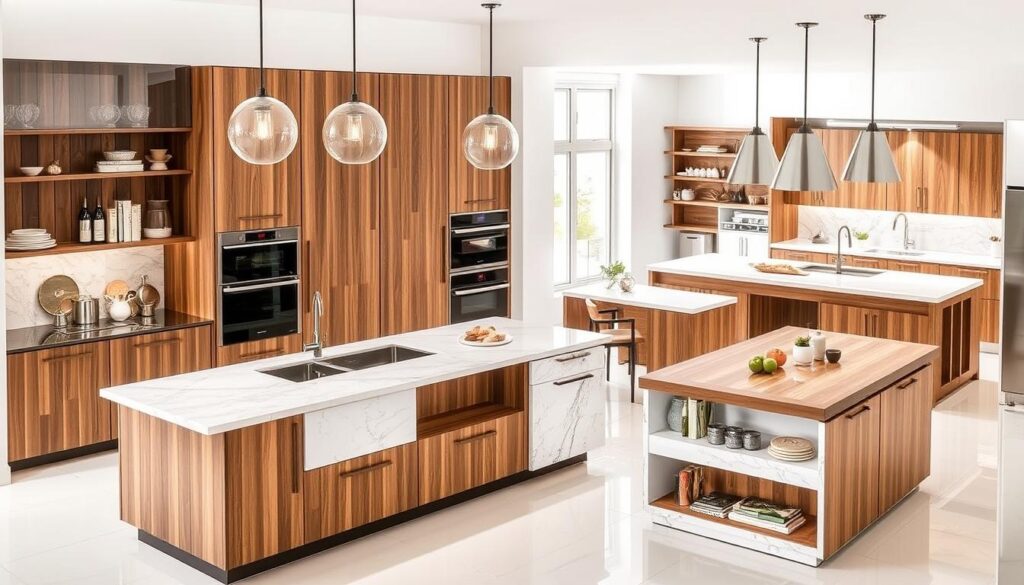Discover why kitchen islands remain a popular design choice. Are kitchen islands still trendy? Learn about their enduring appeal and versatile functionality in modern homes.
Key Takeaways
- Kitchen islands continue to be a popular addition to kitchens, offering extra space and versatility.
- Trends like waterfall edges, tiered designs, and bold color choices are keeping kitchen islands fresh and modern.
- Islands are often seen as the hub of the home, facilitating various activities and defining different zones.
- Proper sizing and layout of the island are crucial to maximize functionality and flow within the kitchen.
- Kitchen islands are expected to remain a staple feature, with a focus on enhanced practicality and openness for cooking, entertaining, and socializing.
The Enduring Appeal of Kitchen Islands
Kitchen islands have long been a staple in modern kitchens, and their popularity shows no signs of waning. In fact, open-plan kitchen ideas featuring kitchen islands as the centerpiece between cooking and living spaces have become increasingly popular, particularly in larger kitchens. Kitchen experts argue that this trend is driven by the social design of kitchen islands, which facilitate inclusive and communal cooking environments.
Beyond their aesthetic appeal, kitchen island benefits are numerous. These versatile features offer additional counter space, storage, and functionality, making them ideal for meal preparation, cooking, dining, and even serving as makeshift workspaces in homes without dedicated offices. Kitchen islands can be equipped with built-in cabinets, drawers, shelves, and custom worktops, providing efficient workflow options and ample storage solutions.
Benefits of Having a Kitchen Island
- Provides extra counter space and storage
- Facilitates social and inclusive cooking environments
- Offers versatility for meal preparation, dining, and remote work
- Can be customized with integrated cabinets, drawers, and worktops
- Suitable for a wide range of kitchen sizes and designs
Contrary to past perceptions, kitchen island functionality has evolved, and they can now be tailored to suit various kitchen sizes and design styles. From harvest tables and floating shelves to bespoke countertops and double islands, the options for kitchen island design are vast, catering to the diverse preferences and needs of homeowners.
Kitchen islands are considered a worthwhile investment, not only for their practical benefits but also for their ability to add value to a home through enhanced aesthetic appeal and modern kitchen design features. This makes them an attractive proposition for prospective homebuyers, further contributing to their enduring appeal.
Surprising Benefits of Kitchen Islands
In the ever-evolving world of kitchen design, the kitchen island remains a sought-after feature, offering a multitude of surprising benefits beyond just extra counter space. Designers and homeowners alike have discovered the versatility of kitchen islands in defining distinct areas within a large kitchen, creating a clear separation between the working space and the rest of the home.
One of the key advantages of kitchen islands is their ability to keep the cook connected to the rest of the household. Designers often recommend keeping islands clear of seating and sinks, as they see them as the perfect prep spot that allows the cook to remain engaged with family and guests while preparing meals. This connectivity can foster a sense of community and togetherness in the heart of the home.
- Kitchen islands are a popular feature in home renovations, with many homeowners prioritizing them as an essential element.
- There’s no size limit to how narrow a kitchen island can be, allowing for customized solutions to suit any kitchen layout.
- Ergonomic considerations, such as providing 30 inches per stool for a seating area, are essential in kitchen island design.
- Additional storage is a primary reason homeowners choose to incorporate a kitchen island, showcasing its practicality and functionality.
The versatility of kitchen islands extends beyond just their design; they can also serve as a convenient hub for appliances. Many homeowners opt to integrate microwaves, cooktops, and even dishwashers into their kitchen islands, creating a seamless and efficient workflow. This integration can enhance the functionality of the kitchen, making it a true multifunctional space.
The trend of having multiple kitchen islands is also on the rise, as homeowners seek to maximize their kitchen’s functionality and design. Custom-designed kitchen islands that cater to individual needs and preferences are becoming increasingly popular, reflecting the growing demand for tailored solutions that suit the unique requirements of each household.
“Kitchen islands are still a popular staple in homes, with many homeowners prioritizing them as an essential feature.”
The enduring appeal of kitchen islands is undeniable, as they continue to evolve and adapt to the changing needs and preferences of modern homeowners. With their versatility, functionality, and ability to define distinct areas within the kitchen, it’s no wonder that kitchen islands remain a coveted element in kitchen design.
Islands Make a House a Home
Kitchen islands have become the heart of the modern home, serving as the hub of activity where families gather, entertain guests, and create cherished memories. Designers emphasize that these versatile workstations are the perfect spot for hosting casual gatherings, allowing hosts to interact with visitors while preparing food or setting out a delectable cheese board.
The kitchen island has evolved beyond a mere functional element, now playing a crucial role in making a house feel truly like a home. These islands have become the epicenter of family life, where kids do their homework, adults work remotely, and shared meals are enjoyed in a relaxed, inviting atmosphere.
The design of kitchen islands has also become a reflection of the homeowners’ personal style and values. From mid-century modern to Victorian-inspired, West-Coast to old-world themes, the islands featured in the material showcase a diverse range of styles and materials, including marble, porcelain, wood, and quartz.
Customizations for kitchen islands cater to specific needs, such as creating a hardworking space for homework, crafts, and baking to accommodate family activities. Designers also incorporate innovative features like hidden TV mounts within the islands to maintain the aesthetic of the kitchen while providing convenient entertainment options.
The versatility of kitchen islands is truly remarkable, as they seamlessly transition from being a functional workspace to a gathering place for loved ones. Whether it’s serving as a dining table, a desk, or a storage hub in compact living areas, these islands have become the heart and soul of the modern home, making a house feel truly like a cherished and welcoming abode.
Defining Distinct Areas with Islands
Kitchen islands are more than just a functional addition to the cooking space – they can help define distinct zones within a large, open-concept kitchen. Designers often recommend keeping kitchen islands clear of sinks and seating, as this helps establish the island as the ideal prep area that keeps the cook connected to the rest of the home.
Keeping Islands Clear for Prep Space
By maintaining a clear, unobstructed work surface on the kitchen island, it becomes a dedicated space for meal preparation. This delineation helps create a smooth flow and better functionality, as the cook can easily access ingredients and tools without having to navigate around other kitchen activities. The island’s central position also allows the chef to interact with guests or family members while prepping, fostering a more social and connected cooking experience.
Islands play a crucial role in kitchen island design, kitchen island layout, and kitchen island zoning. They can be used to define different areas within the kitchen, such as a prep zone, a dining area, and a casual seating space. This strategic use of the island helps optimize the kitchen’s workflow and create a more organized, efficient workspace.

Ultimately, the key to a well-designed kitchen island is keeping the prep space clear and unencumbered. This allows the island to serve its primary function as the heart of the kitchen, where the cook can work seamlessly while still engaging with the rest of the household.
Creating the Coveted Kitchen Triangle
The kitchen triangle – the seamless arrangement of the stove, sink, and refrigerator – has long been the hallmark of efficient kitchen design. Larger, L-shaped kitchens or kitchens with cabinets along one wall are better suited for kitchen islands, as this layout helps create the highly coveted kitchen triangle.
This triangular arrangement allows for easy flow and function within the kitchen, making the island a crucial element in achieving this optimal layout. The traditional kitchen work triangle, developed by the University of Illinois School of Architecture in the early 20th century, emphasized arranging these three key areas in a triangular layout to optimize workflow.
However, modern homes with small apartment kitchens, open floor plans, and multiple cooks have altered the dynamics of the traditional work triangle setup. Designers are now exploring alternative layouts, such as work zones, which divide the kitchen space into specific task areas like a ‘consumable zone’ and a ‘cook zone’ to enhance workflow organization.
The concept of acute or obtuse angles can also be considered for the kitchen layout, rather than strictly adhering to a traditional equilateral kitchen triangle. The key is to create a design that promotes efficient movement between the cooking, food preparation, and storage areas, with the kitchen island playing a central role in this process.
Ultimately, the kitchen island has become a versatile and essential element in modern kitchen design, offering homeowners a range of benefits beyond just creating the coveted kitchen triangle. By thoughtfully integrating the island into the overall kitchen layout, homeowners can enjoy a highly functional and visually appealing space that caters to their unique needs and preferences.
Versatile Island Variations
As kitchen design evolves, so do the options for islands. For homeowners with small kitchen spaces, traditional large islands may not be a feasible solution. However, innovative island alternatives offer the same functional benefits without sacrificing precious square footage.
Options for Small Kitchens
Rolling islands or kitchen island carts are a fantastic option for compact kitchens. These movable and adaptable islands provide extra countertop space and storage, while their compact size allows for easy maneuvering. Another clever solution is the kitchen peninsula, which extends the countertop from the wall, creating a distinct work area without taking up valuable floor space.
- Rollable kitchen islands or carts for added flexibility
- Kitchen peninsulas that extend the countertop from the wall
- Dining tables that double as multi-functional workspaces
In open-plan kitchen designs, a dining table can often serve a similar purpose to a traditional island, providing a central gathering and work area. This versatile approach maximizes the available space and integrates the kitchen seamlessly with the rest of the living area.

“We’ve seen a growing trend of homeowners opting for more adaptable and space-saving island solutions, especially in smaller kitchens. Rolling islands and peninsulas have become popular choices that deliver the same functional benefits without overwhelming the room.”
– Interior Designer, Sarah Johnson
Are kitchen islands still trendy?
Kitchen islands have been a staple in kitchen design for years, and their popularity shows no signs of waning. In fact, the kitchen island has evolved from a mere functional element to a true design centerpiece that can transform the entire aesthetic of a space.
While some recent kitchen design trends have focused on more minimalist, streamlined approaches, the kitchen island remains a coveted feature that homeowners and designers alike are eager to incorporate. The versatility of the kitchen island, coupled with its practical benefits, has solidified its position as an enduring trend in the world of kitchen design trends.
In recent years, we’ve seen a growing trend towards multiple islands in a single kitchen. This approach not only increases storage capacity but also creates distinct work zones and improves the overall visual openness of the space. The kitchen island popularity is further evidenced by the fact that many homeowners consider it an essential element when designing their dream kitchen.
Designers are also embracing the opportunity to experiment with the kitchen island trends, incorporating unique materials, finishes, and decorative elements to make these islands true focal points. From bold colors and mixed materials to sleek, minimalist designs, the kitchen island has become a playground for creative expression.
As kitchens continue to evolve and adapt to the changing needs of modern households, the kitchen island is likely to remain a beloved and integral part of the space. Whether it’s a single, statement-making island or a pair of complementary workstations, the kitchen island’s enduring appeal is a testament to its ability to enhance both the functionality and the aesthetics of the heart of the home.
Choosing the Right Island Size
When it comes to kitchen islands, getting the size just right is crucial. The kitchen island should be proportional to the overall size of the space, with larger kitchens able to accommodate larger islands. Designers recommend a minimum of 42-45 inches of walkway space around the kitchen island, and if there are stools, a minimum of 48 inches.
Factors like the kitchen’s shape (L-shaped or U-shaped) and the desired features (such as a sink, storage, or appliances) should also be considered when determining the ideal island size and layout. A general guideline for the width of a kitchen island is at least 24 inches, while for smaller kitchens, a compact island of around 3 by 4 feet can provide valuable workspace. In larger kitchens, a massive island measuring 4 by 8 feet or more is recommended for ample kitchen island size, kitchen island dimensions, and kitchen island layout.
| Kitchen Island Dimensions | Recommended Clearance | Seating Considerations |
|---|---|---|
| Solid surface countertops: 122-144 inches Natural stone/marble: 105-110 inches |
36 inches between island and surrounding countertops 42 inches for high-traffic areas |
24 inches of counter space per stool 8-foot length for 4 stools |
The decision on the size of a kitchen island ultimately depends on personal preferences and household needs. Thoughtful consideration of factors such as lifestyle, kitchen layout, and personal style can guide the design of a perfect kitchen island size.
“A good rule of thumb is to keep a kitchen island no more than 10 percent of your kitchen’s total square footage.”
Island Design Trends for 2023
As kitchen islands continue to be a focal point in modern kitchens, designers are constantly exploring new trends to keep up with evolving lifestyle demands. The latest kitchen island design trends for 2023 showcase a diverse range of styles and functionalities, catering to both aesthetic and practical needs.
One notable trend is the resurgence of curvaceous island designs, which were popular in the 80s but are now making a comeback, offering a softer, more organic aesthetic. Additionally, the demand for family-friendly kitchen islands is on the rise, with islands that cater to cooking, dining, socializing, and relaxing all in one space.
Sustainability is also a growing concern in kitchen design, with an increased use of natural materials like wood. Unique island shapes are gaining popularity as well, allowing for visually impactful design elements. Larger kitchens are also becoming more prevalent, leading to the inclusion of grand and glamorous islands that serve as the focal point of the room.
| Trend | Description |
|---|---|
| Curvaceous Design | Comeback of 80s-style curvaceous island designs for a softer, more organic aesthetic. |
| Family-Friendly Functionality | Kitchen islands catering to cooking, dining, socializing, and relaxing in one space. |
| Sustainable Materials | Increased use of natural materials like wood in kitchen island design. |
| Unique Shapes | Visually impactful island designs with unique and eye-catching shapes. |
| Larger, Grander Islands | Grand and glamorous islands serving as focal points in larger kitchen spaces. |
These trends in kitchen island design and kitchen design trends for 2023 showcase the ever-evolving nature of kitchen islands, as designers strive to create functional and visually appealing spaces that cater to the needs of modern homeowners.
“The kitchen island has become the heart of the home, and designers are responding with innovative designs that capture the essence of modern living.”
Conclusion
In conclusion, the evidence from various sources suggests that kitchen islands remain a highly sought-after and practical feature in modern kitchen design. While the island may have taken a less dominant role in some recent kitchen trends, it is clear that the kitchen island is not going away anytime. The island’s versatility, functionality, and ability to bring a sense of community to the heart of the home make it an enduring and valuable element in kitchen design.
As homeowners and designers continue to explore new island variations and features, the kitchen island is poised to remain a trendy and essential part of the modern kitchen. The growing popularity of small kitchen island designs, nature-friendly designs, and multifunctional islands with personalized features suggest that the kitchen island’s importance in kitchen design is only set to increase.
Ultimately, the kitchen island’s enduring appeal, coupled with its ability to enhance the functionality, aesthetics, and community feel of the kitchen, make it an invaluable component of modern kitchen design. As homeowners and designers continue to prioritize kitchen island benefits and the latest kitchen design trends, the kitchen island is certain to maintain its status as a must-have feature in the heart of the home.













